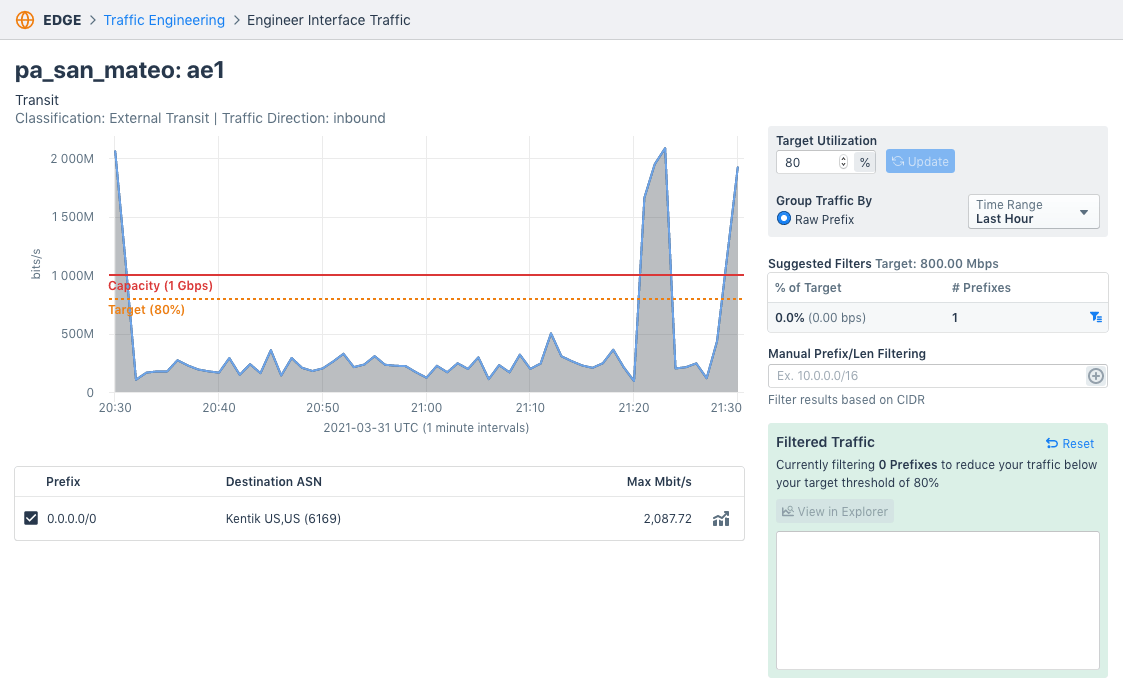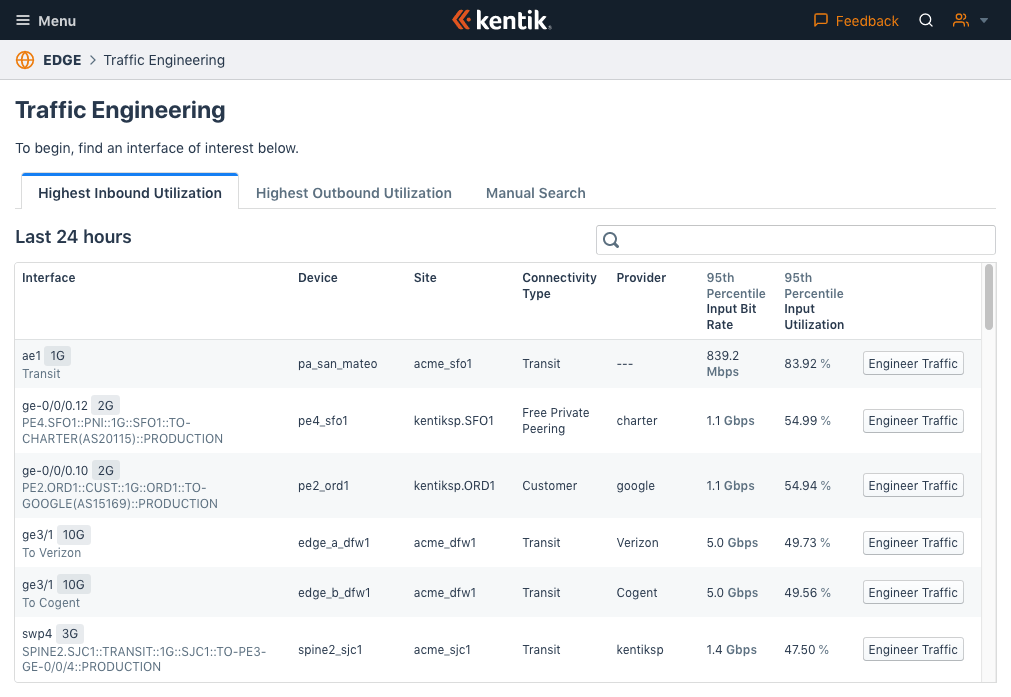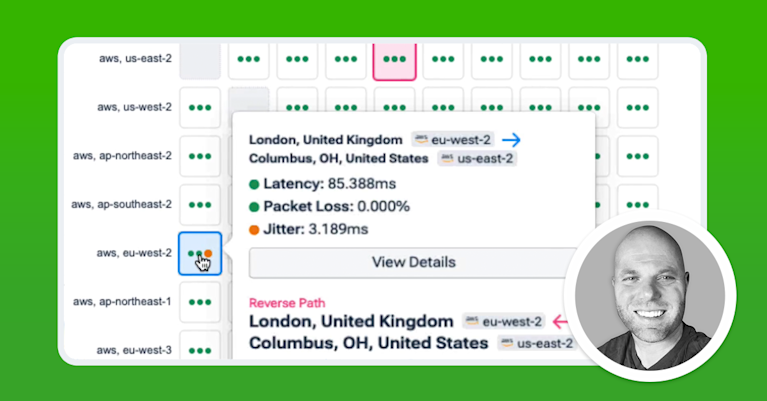Network Traffic Engineering
Network traffic engineering is a fundamental aspect of managing and optimizing network performance. It involves a blend of strategies, technologies, and tools designed to effectively control and distribute network traffic. As networks continue to evolve, with increasing complexities and volume of data, traffic engineering has become an essential strategy for ensuring optimal network functionality and user experience.
What is Network Traffic Engineering?
Network Traffic Engineering is the practice of adjusting and managing data flow across network infrastructure to improve operational performance, reduce congestion, and control costs. It encompasses the strategies and techniques used to manipulate and optimize network traffic distribution, often through intelligent routing decisions, capacity planning, and load balancing.
In the context of the internet and IP networks, this typically involves using Border Gateway Protocol (BGP) policies to direct traffic from one network peer to another based on various criteria such as cost, capacity, latency, or policy considerations.
Proactive and efficient network traffic engineering can substantially improve overall network performance, resilience, and cost-effectiveness.
The Importance of Network Traffic Engineering in Managing Network Performance
In a world where networks handle unprecedented amounts of data, network traffic engineering has emerged as a critical strategy for managing network performance. Effective traffic engineering can significantly enhance the performance and reliability of a network.
First, by redistributing network loads, traffic engineering can prevent network congestion, a common cause of packet loss and latency. By strategically rerouting traffic, network administrators can ensure that network infrastructure is used to its full potential and that no single link is overburdened.
Second, traffic engineering can also contribute to enhanced network resilience. By designing multiple routes for data flow, networks can maintain performance even during failures or unexpected spikes in traffic.
Finally, network traffic engineering aids in optimizing operational costs. With the ability to reroute traffic based on various metrics such as path cost or capacity, administrators can ensure that resources are used cost-effectively.
The Relationship Between Network Traffic Engineering and Routing Protocols
Network traffic engineering is closely linked with routing protocols – the rules or standards that dictate how routers communicate and exchange information on a network. These protocols determine the paths data packets take when moving from source to destination.
Path selection among interior gateway protocols is typically based on shortest-path algorithms, which do not consider real-time network conditions or capacity. However, this can lead to unbalanced network load distribution and potential bottlenecks.
With traffic engineering, routing decisions can be made more intelligently. For example, many network service providers use Multi-Protocol Label Switching (MPLS) or Border Gateway Protocol (BGP) policies to enable dynamic, condition-based routing. This helps optimize network performance by considering factors like bandwidth, latency, cost, and network policy, in addition to the shortest path. Similarly, enterprise NetOps teams will use interior gateway protocols such as OSPF and IS-IS, policy-based routing methods, and network overlay technologies to make intelligent path selections.

The definitive guide to running a healthy, secure, high-performance network

Key Challenges and Problems Addressed by Network Traffic Engineering
Network traffic engineering tackles several challenges and problems inherent in network management.
-
Network Congestion: Traffic engineering helps redistribute network load to avoid overloading specific links, thus preventing network congestion and the resulting packet loss and latency.
-
Unbalanced Traffic Distribution: Traditional routing protocols might lead to unbalanced traffic distribution. Traffic engineering techniques ensure that network load is optimally distributed across all links.
-
Network Resilience: By designing multiple potential routes for data flow, traffic engineering improves network resilience, ensuring continuity of service even when some network elements fail.
-
Cost Optimization: Traffic engineering allows traffic routing based on cost-effective paths, leading to operational cost savings.
-
Quality of Service: Network administrators can better meet Quality of Service (QoS) requirements through efficient traffic engineering, ensuring critical traffic is prioritized and gets the necessary bandwidth.
Traffic engineering addresses these challenges, contributing to more reliable, high-performing, and cost-effective networks.
Multi-Protocol Label Switching (MPLS) and Traffic Engineering
Multi-Protocol Label Switching (MPLS) is a networking routing scheme that can be useful in network traffic engineering, significantly enhancing efficiency and performance. Designed as an alternative to traditional IP routing, MPLS streamlines the packet routing process by introducing a labeling system, thereby bypassing the need for each router in a path to look into its routing table for the destination of each incoming packet.
MPLS allows a network operator to define a label-switched path (LSP) across a set of label-switch routers (LSRs). The LSP encompasses an ingress router and an egress router, with a set of transit routers in between. This ingenious design expedites the routing process and contributes to Quality of Service (QoS) as additional bits in MPLS labels can be used to assign different priorities to varying types of data.
Network operators can leverage Kentik’s comprehensive support for MPLS to manage and optimize their network traffic effectively. Understanding the intricacies of MPLS, how it influences data routing, and how it can be used for traffic engineering is important for efficient network performance.
Link Utilization Optimization in Traffic Engineering
Understanding Link Utilization and its Importance in Traffic Engineering
Link utilization refers to the percentage of total network capacity consumed by data traffic at any given time. It provides a quantitative measure of how efficiently a network’s resources are being used and is an essential metric in traffic engineering. High link utilization can indicate that a network is nearing capacity, risking congestion and degraded performance. On the other hand, consistently low link utilization may suggest overprovisioning and unnecessary costs.
In the context of traffic engineering, understanding and monitoring link utilization is paramount. It provides crucial insights into network behavior, traffic patterns, and potential bottlenecks, enabling network administrators to make informed decisions about network management and optimization. Link utilization also serves as a foundation for setting utilization targets, a critical step in proactive traffic engineering strategies.

Techniques for Optimizing Link Utilization in Traffic Engineering
Several techniques can be employed to optimize link utilization in traffic engineering, enhancing network performance and cost-effectiveness:
-
Capacity Planning: Network administrators can predict future capacity needs more accurately by continually monitoring link utilization and understanding traffic patterns. This allows for informed decisions about when and where to scale network resources, ensuring optimal utilization.
-
Load Balancing: This involves distributing network traffic across multiple links or paths to balance the load and avoid overutilizing a single link. Techniques such as Equal-Cost Multi-Path (ECMP) routing or MPLS traffic engineering can help achieve this.
-
Dynamic Routing: Using advanced BGP mechanisms, policy-based MPLS label switching, dynamic interior gateway routing, and various programmatic control plane devices available today, we can now route network traffic based on real-time network conditions. This can optimize link utilization by directing traffic away from congested, poorly performing, and otherwise oversubscribed links.
-
QoS Policies: Implementing Quality of Service (QoS) policies can control and prioritize traffic based on the type of data, its importance, and the required bandwidth. This helps optimize link utilization by ensuring critical traffic gets the necessary resources while less critical traffic is routed to less utilized links.
-
Traffic Shaping: Traffic shaping, also known as packet shaping, involves controlling the volume of traffic being sent over a network link at a given time. This can help manage link utilization, prevent congestion, and ensure smoother network performance.
Network administrators can achieve a more balanced, resilient, and cost-effective network by effectively monitoring link utilization and applying these optimization techniques. Tools like Kentik’s Traffic Engineering module can be instrumental in this process, providing in-depth insights and recommendations to optimize link utilization and overall network performance.
Traffic Engineering with Kentik
Kentik offers a comprehensive Traffic Engineering module integrated into its network observability platform. This tool allows network professionals to understand, control, and optimize network traffic patterns. It helps avoid congestion, minimize downtime, control network costs, and improve overall performance.
Here’s how Kentik’s Traffic Engineering feature works:
-
Identify Traffic Patterns: Using the Kentik platform, users can gain insight into traffic patterns over any specific network interface.
-
Set Utilization Targets: Users set a target utilization level - the desired level of traffic volume as a percentage of interface capacity.
-
Analyze and Recommend: Kentik’s platform analyses the link capacity across your network, considering the device, interface, and direction, and recommends groups of AS Paths or source/destination prefixes through which excess traffic can be rerouted.
-
Visualize the Impact: Kentik’s platform lets users see the impact of these potential changes, helping to understand the outcomes of rerouting certain traffic groups.
-
Implement Decisions: Once the user has decided which traffic should be rerouted, Kentik allows them to copy the list of groups and use it to implement their decisions in a network management tool.
Kentik’s Traffic Engineering module provides NetOps professionals with the necessary tools to make data-driven decisions about their network traffic, helping them proactively manage and optimize network performance. To learn more about Kentik’s traffic engineering capabilities and how they can benefit your organization, request a demo or sign up for a free trial today.


